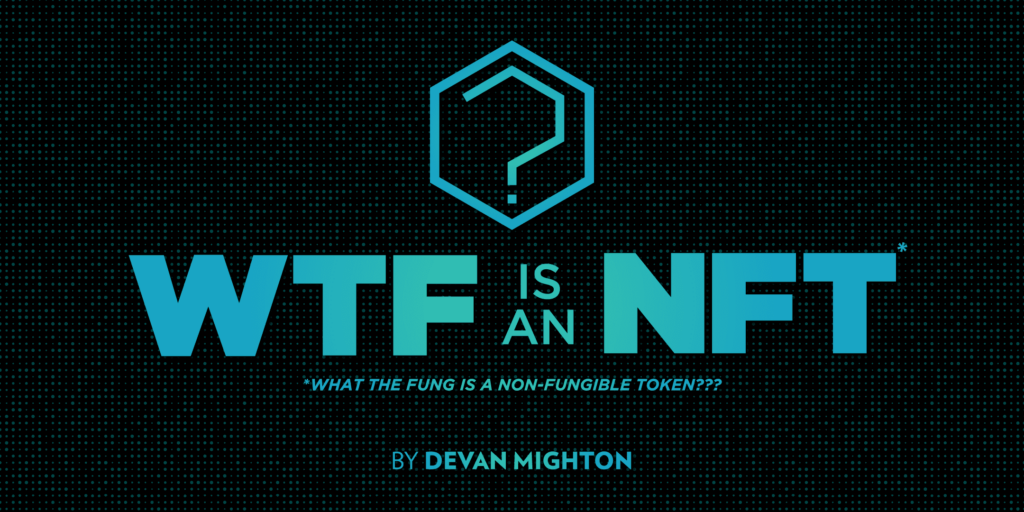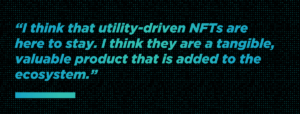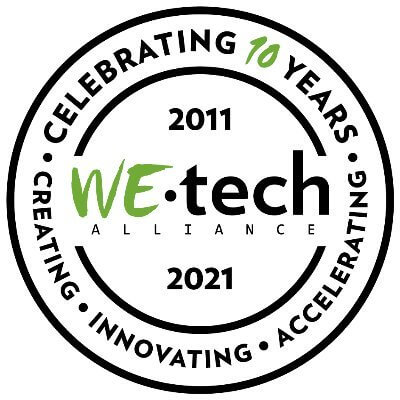Home » WTF is an NFT? The inside scoop on the hottest trend in crypto.
WTF is an NFT? The inside scoop on the hottest trend in crypto.

The inside scoop on the hottest trend in crypto.
If you have been watching the news, keeping up on your social media, or chatting around the watercooler, you have no doubt heard at least a passing reference about NFTs.
What exactly are they? We don’t blame you for asking that question.
On March 23rd, as part of WETechAlliance’s 5th Annual TeCK Week YQG, Ethereum co-founder and Decentral CEO Anthony Di Iorio will be participating in a fireside chat as part of Tech Founder Day. In anticipation of this exciting event, we have decided to dive neck-deep into the world of crypto and give our members a crash course on the ins and outs of the wild world of NFTs.
What The Fung?
So, what is an NFT? The oft-heard acronym stands for Non-Fungible Token. Well, what the heck is that? Let’s reverse engineer it. A token–well, that should be simple enough–think of a bus token. It is a pass, a certificate, an agreement or contract of sorts that serves a purpose. How about that big word–fungible? Well, that is an object with assigned value. An NFT is non-fungible, which means there is no guaranteed assigned value.
In a non-virtual world, what would be a good analogy? Well, a painting would qualify as a non-fungible asset. It has no guaranteed value and is controlled by market forces. Now, imagine that owning a print of that painting could gain you an audience with its painter–now it has become a token as well. In a loose sense, that is what an NFT is in the virtual world.
“There are levels to it, so many levels, and it can get very complicated,” explains Greg Carron, aka pixeladdikt. “Is it safe? That’s complicated. It depends on how tech savvy you are, and now it’s not even tech savvy, it’s blockchain and wallet savvy.”
Carron has been in the digital realm since 1997, and a portfolio client of WETechAlliance since 2019. Since becoming a freelancer about five years ago, he considers himself a jack-of-all-trades in the digital/virtual world and works with developers, designers, companies like Nike, and music artists like Naughty By Nature and Run DMC, to create virtual worlds and applications that put NFTs to use.
On top of running eCommerce profiles for a number of high-end clients, Carron is collaborating with Vin Rock of Naughty By Nature on a new company known as Nuconomi that works as an agency in collaboration with artists, labels, and publishers to build metaverses (virtual worlds) using Microsoft-provided virtual cameras that create a live beam-in they call holoportation to provide live virtual events such as concerts, meet-and-greets, and conventions–all utilizing NFT-based access.

“[NFTs are] a unique digital asset on a blockchain that represents some form of digital asset–whether it’s an art piece or music, but it’s a contract–make no mistake,” he says. “It’s a piece of code that lives on a blockchain that is a contract, but it’s verifiable, it’s immutable, you can’t change it. The best thing is, in that contract, artists can write that you can buy this, but if you resell it, if there’s an economy around my kind of work, I can get a small percentage every single time. You can now value a lot of your digital assets that people can buy and trade. There’s a new economy now.”
Also, because of their verifiability, Carron says they are useful in many fields to professionals like lawyers, restaurant owners, real estate agents, and music artists. Their applications are virtually unlimited.
“Once somebody mints a NFT, they’re minting it on the blockchain so that no one can touch it, no one can claim it. You can do shady things in the real world. You can sell fake things to people. Well, in this digital world–this new metaverse–you need to have a form of verifiable digital assets, and that is all this is.”
The market assigns the value of the NFT–it’s pure supply and demand. Rarity and uniqueness are highly sought after with different types of NFTs, often art, being sold for shocking sums of money.
“People are like, ‘Can I buy one?’ Well, it depends,” cautions Carron. “Yes, you can, but you’ve gotta learn how to buy Ethereum off of CoinBase and move it to a wallet and then go on this website to connect your wallet–and then you can buy one.”

However, there is a lot to know and consider if you choose the route of investing in NFTs.
“As an investment, I think that I would consider them very risky,” opines Paul Blizzard of the Bereskin & Parr LLP law firm. “It’s important that if you are going to be putting your money into buying one that you understand what the risks are. There’s a lot of NFTs selling for a lot of money. There’s a lot of them where it’s questionable whether the prices being paid are at all reasonable. So, I think there’s a lot of criticism that they are like a pyramid scheme or a ponzi scheme because who knows what’s going to happen in six months or a year when the market shifts or people are no longer interested in it.”
Blizzard also worries about the legitimacy of the contract aspect of NFTs.
“The majority of the NFTs that are being bought and sold are on the Ethereum blockchain,” explains Blizzard. “The way that they are purchased is using something called a smart contract where, basically, you have an address for the contract, you send it money and it will mint or create you an NFT that you receive and can be bought and sold between people as well.”
“A smart contract is not necessarily the same thing as a legal contract,” he continues. “There’s a bit of a question about when you buy a thing, what is actually owned? For the most part, on the Ethereum blockchain, when you buy an NFT, what you are actually receiving is basically a receipt. You get an entry, listing you as an owner on the blockchain, and what is basically in there is a link to metadata that includes the information about the asset.”
He also cautions the purchasing of artwork NFTs, as there is no guarantee that the art sold is free of a copyright claim or could be subject to one in the future. “There are some things that people are trying to do in NFTs that are not kosher with copyright law,” states Blizzard. “You have to respect the rights of the owner and there’s a whole licensing scheme that exists and has existed for a long, long time outside of this NFT bubble.” Also, due to the size of many NFTs that contain images or otherwise, Blizzard says they are often stored “off-chain”. Meaning that the Ethereum blockchain that needs them is linked to a metadata service. If this service ever goes down or goes out of business unceremoniously, it may be hard for the NFT user to prove meaningful ownership of the asset.
All in all, one of Blizzard’s biggest concerns is that the NFT may be a fad.
“I think that purchasing them for the purpose of an investment is probably a poor idea,” he offers. “If there is a piece of art that you really like or you’re a creator and you want to generate your own art and sell it and use it in this technology, that’s a great idea, that’s totally fine in terms of how to use it. I would have some significant caution in terms of whether you are purchasing them as an investment. It’s fine now because it’s a popular thing and there’s lots of people who are buying and selling these things all the time, but, in the long run, who knows what’s going to happen in a year or five years from now.”

However, Colin Hart, project manager of Thor Financial and founder of Hive Investments, believes there is too much focus on the art-side of the NFT world and that utility-based NFTs are the future. “[Art] NFTs are personally the ones I hate and I think that those NFTs exist in a bubble,” explains Hart. “I think that any asset that is based on pure speculation is an asset that is doomed to fail from a long-term perspective.
“The NFTs that I am a part of are NFTs that have in-baked utilities. I think that utility-driven NFTs are here to stay. I think they are a tangible, valuable product that is added to the ecosystem. I think that things that are just art or a jpeg that you can easily press copy-and-paste on, I think those are inherently a bubble and they’re built on hype in the community. Once that hype dies down, the floor price will drop significantly over time.”
Hart is heavily involved in DeFi, short for Decentralized Finance, and has founded a self-regulatory agency, The Union of Transparency, within DeFi in an effort to help end the “Wild West” perception that crypto has gained and prepare DeFi for the eventuality of government regulators coming into their realm.
He says that NFTs are not something someone can just jump into from the street and excel at.
“Unfortunately, everybody hears about a goldmine and everyone wants to rush to the goldmine, but nobody wants to do the due diligence and research that it takes,” bemoans Hart. “There’s a foundational level of knowledge that needs to be applied and I don’t think that random people on the street that are just hearing how popular NFTs are should be going on to OpenSea and bidding on NFTs. I think they are fundamentally going to get screwed and I think there’s a lot of people there who understand this industry who are going to be taking advantage of those people.”
“What I would recommend to anyone who is interested in NFTs and want to have an opportunity to make good money on those, what they need to do is to find a project that’s pre-launch and still giving out what’s called whitelist allocations–where they’re able to mint and produce NFTs on the blockchain for a preset price and, generally speaking, if it’s a high-quality project with a good amount of utility behind it, that floor price is going to increase over time due to the scarcity element.”
---
Interested in learning more? Join us online on Wednesday, March 23rd for our FREE virtual fireside chat with Ethereum co-founder and Decentral founder and CEO, Anthony Di Iorio!
From cryptocurrency, blockchain, finance and business, this wide-ranging conversation will cover Anthony’s career as an entrepreneur, venture capitalist, community organizer and thought leader, as well as his insights on the “Perfect Formula” for entrepreneurs and leaders looking to grow. RESERVE YOUR SPOT!

Devan Mighton grew up north in Grey County but has called Windsor home for almost two decades. A dedicated father and sports coach, he has worked as a writer and sports photographer for over five years. Currently a freelance writer with The Drive Magazine, he has worked as a regular contributor with TorStar Local online publications, the LaSalle Post, Tecumseh Shoreline Week, and the Lakeshore News, among a number of other publications.
The post WTF is an NFT? The inside scoop on the hottest trend in crypto. appeared first on WETechAlliance.
WETechAlliance
https://www.wetech-alliance.com/
WEtech Alliance has served as a catalyst for technology and innovation in the Windsor-Essex and Chatham-Kent, Ontario regions since 2011. We’re a non-profit organization that provides entrepreneurs and companies with business services, training, I.P. and commercialization support, mentorship and strategic connections to help bring new ideas to market, scale to the next level and build a dynamic culture and a community of innovation.


